The Swiss Doodle is a second-generation mixed breed, created by crossbreeding a tri-color Aussiedoodle with a tri-color Bernedoodle.
If you’ve never heard of them before, and you think they sound too good to be true, it’s because they’ve only been around for around a decade. Not a lot of people know about them, and even fewer know about their temperament, personality, and traits.
So, to clear up the confusion and bring this adorable little breed closer to people, we’ve put together this extensive article. We will be talking about everything Swiss Doodle-related, from the way they were bred to their appearance, personality, and possible health issues.
There will also be word about their needs when it comes to training, feeding, and physical activity. So, if you have plans to adopt a Swiss Doodle, or simply want to know more about them, then this article is a must-read for you.
What Is A Swiss Doodle?
As we already mentioned, the Swiss Doodle is a second-generation crossbreed, which means that both its parent breeds are mixed breeds.
It’s a relatively new and very unique type of designer dog that is slowly becoming more popular in recent times. Although they draw most of the hereditary genetic material from their immediate parent breeds (the Aussiedoodle and the Bernedoodle), their complete genetic makeup can be traced back to three separate pure breeds.
Those three breeds are the Poodle, the Australian Shepherd, and the St. Bernese Mountain Dog. The St. Bernese breed originated from Switzerland, which is what inspired the breeders to name this new breed “Swiss Doodle”.
Swiss Doodle Parent Breeds
Like with any mixed breed, we can’t really talk about Swiss Doodles without talking about their parent breeds. They have a fairly complex family tree, and it ultimately shapes a lot of their traits.
Swiss Doodles were first created by the Crockett family in an attempt to create a dog that is similar to the mini Bernedoodle, but with better health, a higher trainability level, and richer color patterns. They have only been around for a little over a decade, so they are not yet recognized officially by any kennel club.
Eventually, they chose to cross the tri-color mini Bernedoodle with the tri-color mini Aussiedoodle. Both of these are fascinating crossbreeds themselves, so we will give them the attention they deserve.
Aussiedoodle
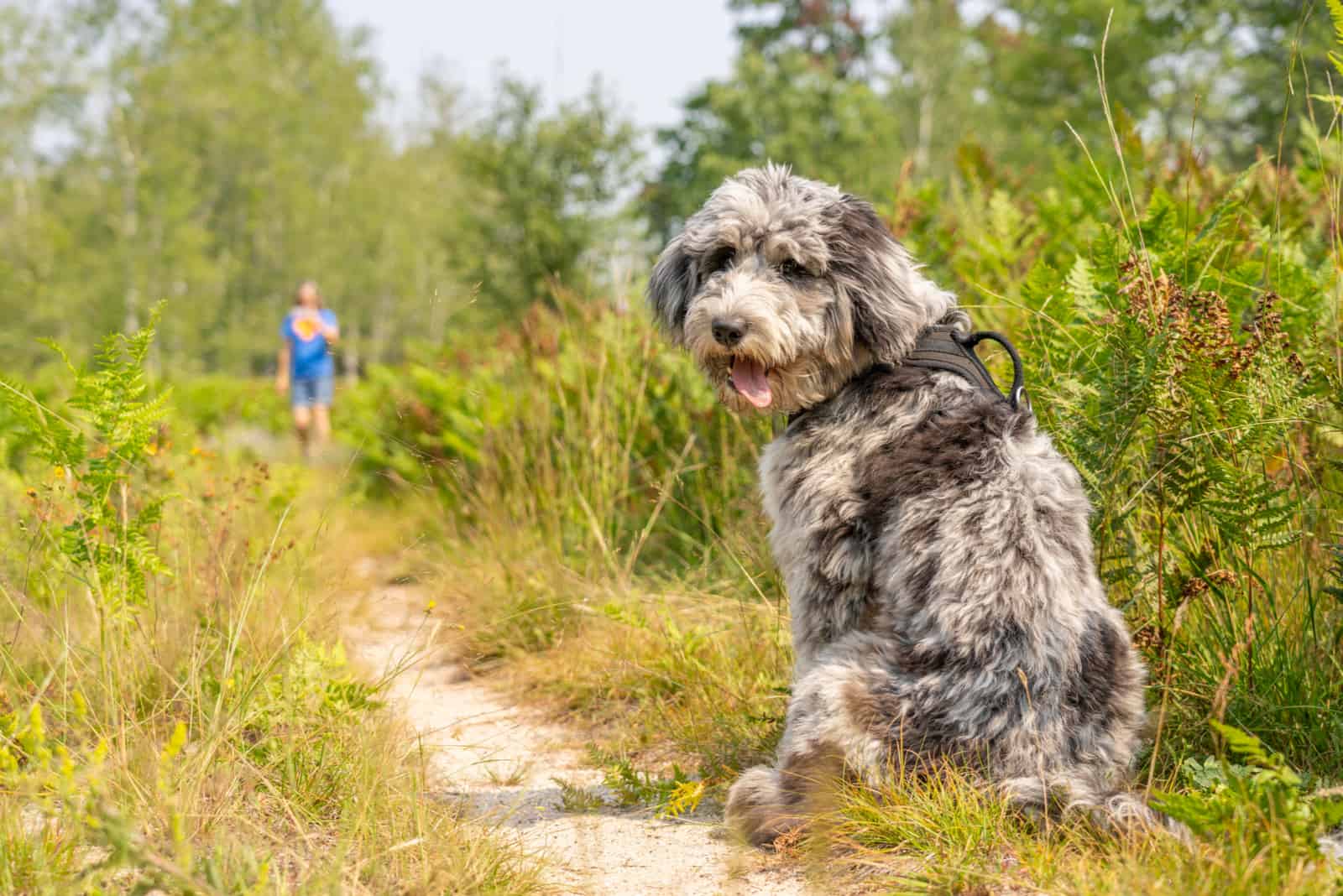
The Aussiedoodle is a mix between the Australian Shepherd and the Poodle. They are known for their intelligence, playfulness, and loyalty. They are sometimes also known as Aussiepoodles and Aussiepoos.
They make for great family dogs because they create such strong bonds with their owner. They grow very affectionate very quickly, which is why kids usually love them.
However, they do require a lot of physical and mental stimulation. If they are not expending their energy regularly, they can sometimes turn to aggressive behavior.
By being a cross between the Australian Shepherd and the Poodle, they’ve inherited some traits from both of these dog breeds, much like their distant cousins — the Australian Labradoodles. They grow up to be between 15 and 25 inches (38.1 and 63.5 cm) in height, and weigh between 25 and 75 pounds (11.3 and 34 kg) in weight, which is just about in the middle of the two parent breeds.
Their coat is usually curly or wavy, and it comes in a variety of patterns, such as blue merle, red merle, black and tan, etc. In order to get them to be tri-color, a lot of experimentation is needed. Breeders will try to cross Poodles with different-colored Aussies until they get a tri-colored puppy.
Bernedoodle
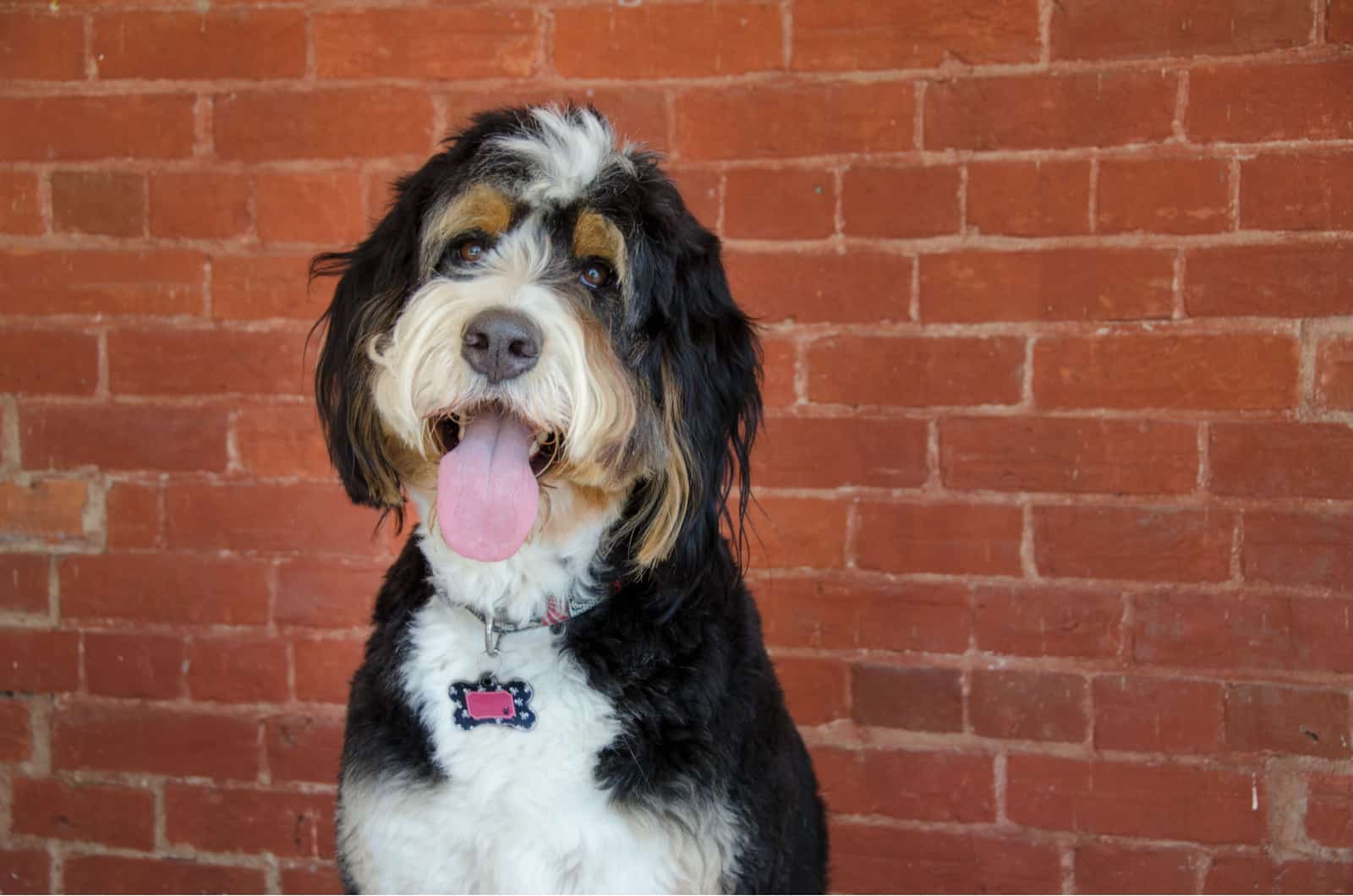
The Bernedoodle is a cross between the St. Bernese Mountain Dog and the Poodle. This breed was originally created with the aim of getting a Bernese Mountain-type dog that doesn’t drool or shed much.
We know that Poodles are generally a good choice for creating mixed breeds. One of the most famous Poodle crossbreeds is the Goldendoodle, but there are a bunch of others that are just as cute. Just take a look at this list.
But, what is a little surprising is how well they mix with a lot of the breeds that come from the Swiss Alps. For example, crossing Poodles with Greater Swiss Mountain Dogs gives birth to a litter of Mountain Doodles – a breed that is almost as cute as the one we are talking about today.
So, when it comes to Bernedoodles, standard-sized poodles are typically used in the breeding process, but breeders sometimes use miniature ones as well. This results in a smaller version of the Bernedoodle.
Speaking of size, Bernedoodles have an average adult height of 23 to 29 inches (53.4 to 73.6 cm), and an average weight of 61 to 100 pounds (27.7 to 45.4 kg). As you can see, they are fairly large dogs, taking after their St. Bernese parents in that aspect.
The mini Bernedoodle is significantly smaller, ranging from 18 to 22 inches (45.7 to 55.8 cm) in height, and 20 to 45 pounds (9.1 to 20.4 kg) in weight. This one is somewhat closer to the Poodle’s size, but it still has a lot of distinct Bernese trademarks.
Bernedoodles are a healthy and long-lived breed that are perfect as companion dogs. They are affectionate, trainable, and super smart, but they need to be accustomed to socialization at a very young age.
In the process of breeding Swiss Doodles, tri-colored mini Bernedoodles are used as one of the parent breeds. The tri-color Bernedoodle has black, rust, and white coloring, and it looks similar to a Bernese Mountain Dog.
What Do Swiss Doodles Look Like?
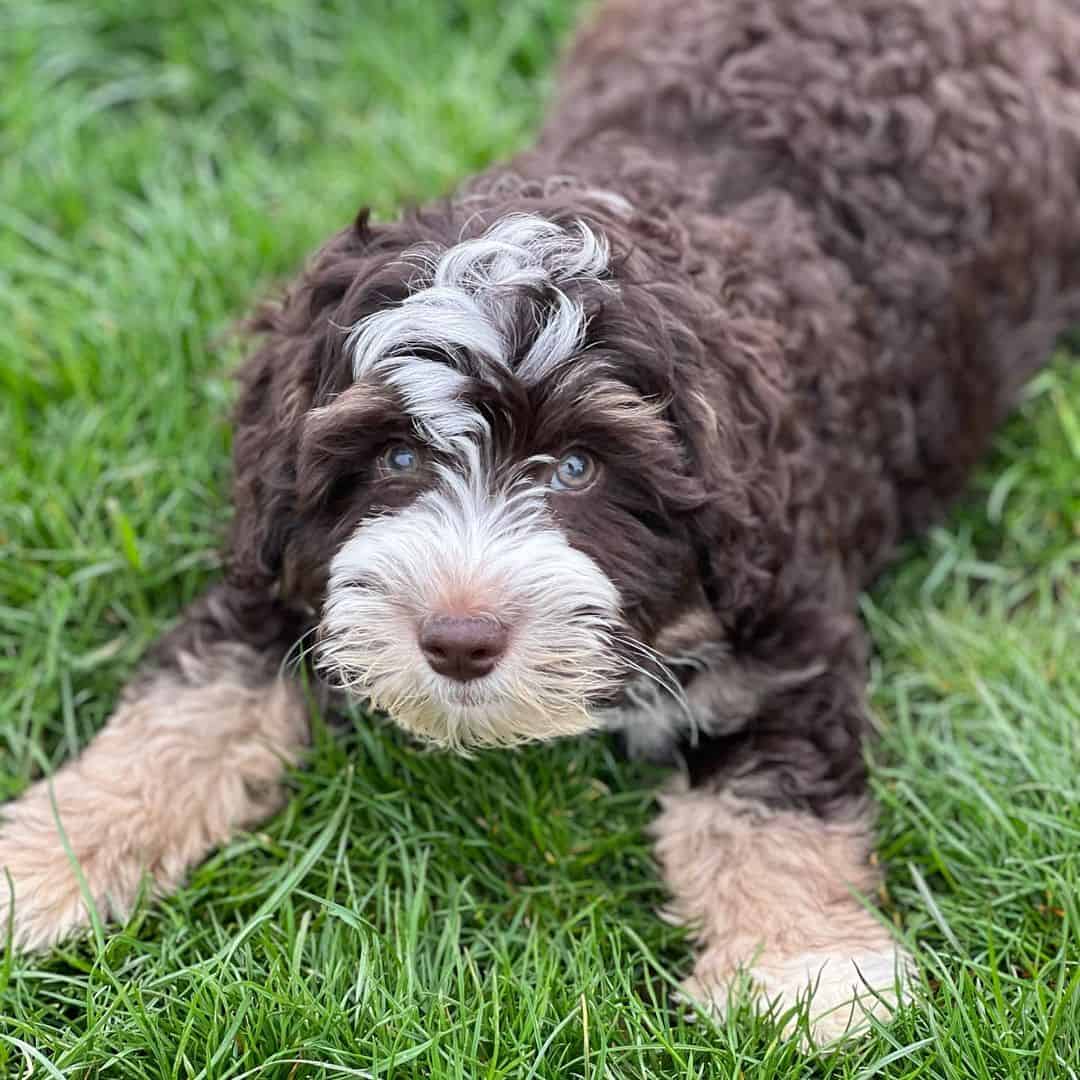
Photo from: @westpenndoodles
After speaking about their parent breeds and their appearance, it’s now time to finally describe what Swiss Doodles look like.
They inherit a lot of traits from all of their genetic ancestors, but in terms of appearance, they are most similar to the St. Bernese Mountain Dog. As we said, this was what the breeders wanted to achieve in the first place, so it’s no surprise that they share a lot of characteristics.
They have a notably stocky body, a short, flat muzzle, and small, round eyes. More often than not, they have a white blaze across their face.
That being said, there is a lot of variety to this relatively new breed, and there are still a lot of things that we don’t know about them and that we can’t predict. With that in mind, let’s go through the major aspects of a Swiss Doodle’s appearance — their size and coat.
Size
In broad terms, Swiss Doodles range from small dogs to borderline medium-sized dogs. At their very tallest, they can grow up to 20 inches (50.8 cm) at the withers, but this is usually not desirable among breeders.
For this reason, they will occasionally use Toy Poodles in the earlier generations of breeding in order to have better odds of getting a smaller Swiss Doodle down the line.
In terms of weight, they can be anywhere between 30 and 55 pounds (13.6 and 24.9 kg) and still be considered healthy and not overweight.
There is a tendency among breeders to aim for smaller-sized Swiss Doodles, so there is a good chance that their height and weight will decrease over time. For now, however, these are the average values.
Coat
Swiss Doodles usually have a wavy or curly coat, but there have been instances of these pups with fully straight hair.
Since they tend to be bred from tri-colored parent breeds, they are often tri-colored themselves. That is the breed ideal, but it’s not always the case.
Black, rust, and white is the most common tri-color combination, and that’s exactly the one that is reminiscent of the St. Bernese Mountain Dog the most.
They can also occasionally come in unique merle and sable patterns or have different color markings around their eyes or across their body. They can even be single-colored, although that is very rare.
Are Swiss Doodles Hypoallergenic?
A hypoallergenic coat is a trait that makes certain dogs less likely to cause allergies in humans. Poodles are probably the best-known example of a hypoallergenic breed, and since they are an ancestor of Swiss Doodles, that trait has been passed down.
It has not yet been 100% confirmed, but a lot of experts agree that Swiss Doodles have a hypoallergenic coat, which is another element that makes them a great house pet.
Swiss Doodle Personality
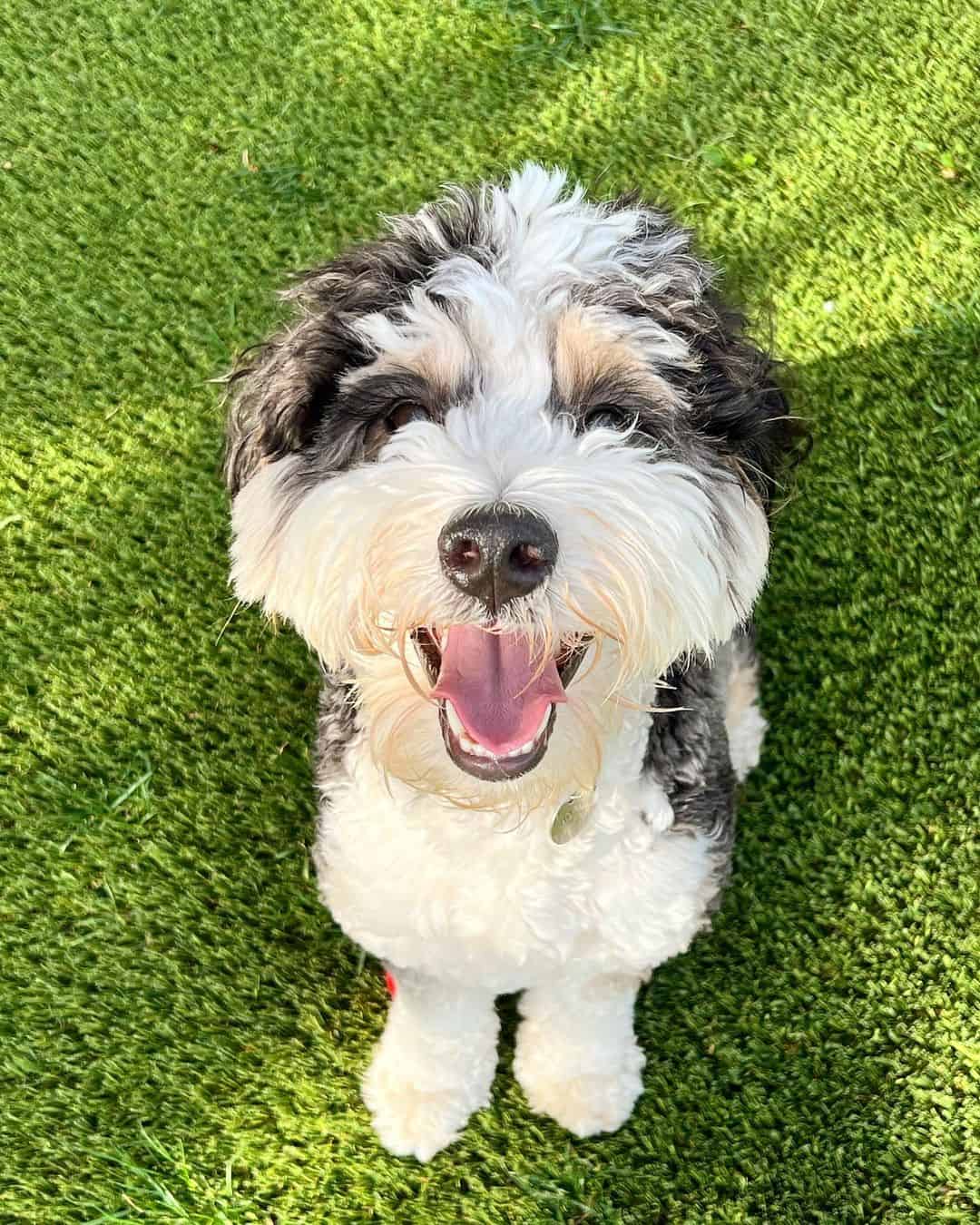
Photo from: hobeybarker
It’s extremely rare that a mixed breed gets the best traits from both of its parent breeds, but that seems to be the case with Swiss Doodles.
They are highly affectionate (but not clingy), sociable, and well-behaved. They get along great with kids, strangers, and other dogs, which is a trademark of both Australian Shepherds and St. Bernese Mountain Dogs.
Training
With so much of their genetic material coming from herding dog breeds, it’s no wonder that they are very receptive to training. In fact, you could even say that they thrive on being told what to do, especially if they know there is a tasty treat at the end of it.
Like so many other dog breeds, Swiss Doodles are best motivated with positive reinforcements. Whether it’s a treat or a pet on the head, they will feel rewarded by it and be excited to do it again.
But, there are some things that you need to pay attention to. Starting early is the most important part of successful dog training. If you wait too long, your Doodle might develop bad habits that will be tough to unlearn later on.
Try teaching them simple commands early on in their puppyhood to test the waters, and build from there.
Behavior
As a rule of thumb, Swiss Doodles are well-behaved, obedient, and calm dogs. It’s simply not in their personality to be aggressive.
However, they do have a lot of energy — must be those Poodle genes! — which needs to be released in an appropriate way. They have a sharp mind, and they need to be constantly engaged. So, while you’re away, for example, if you’re working, you need to find ways to entertain them.
Otherwise, they might start chewing your furniture or digging holes in your garden.
Another thing that you should have in mind is closely related to their training. We’ve already mentioned that they generally adapt well to training, but you need to start early. If you don’t start teaching them good manners in their puppyhood — or if they were already an adult when you got them — they might start showing signs of aggression.
That typically goes against their nature, but those high energy levels of theirs can turn into unwanted behavior if they are not taught what’s right and what’s wrong.
Are Swiss Doodles Good Family Dogs?
All signs point to Swiss Doodles being excellent family dogs, whether you choose to keep them in the house or outside. They will not question your authority or cross any boundaries that you have set for them.
Furthermore, they enjoy spending time with kids as this allows them to be physical and active, which is very important for them. Not only do they like playing with them, but they also develop a deep sense of devotion to children and start acting like their guardians.
And, since they are relatively small in size, they can adapt to either living in a house with a yard, or an apartment in the city. Just make sure, if you live in the latter, that you take them out for walks frequently.
Are Swiss Doodles Good With Other Dogs?
Swiss Doodles are very fond of socialization, and they treasure the companionship of other dogs.
If you already have a four-legged buddy in your home, bringing in a Swiss Doodle will likely not cause any problems as they will be keen on spending time with them.
As we’ve already said, they are not aggressive towards other dogs (unless provoked), whether they’re roommates, the neighbor’s dogs, or just a random pooch that they run into in the park. In fact, they will probably try to become best friends with all of them.
If they happen to show some aggressive tendencies towards other dogs, there are ways you can socialize them not to be aggressive.
Swiss Doodle Health

Photo from: @jefferson_da_miniswissdood
Mixed breeds are usually more susceptible to recurring medical conditions, but that doesn’t seem to be the case with Swiss Doodles.
There is a very limited medical history of this breed because it has only been around for a little over a decade, but so far, there haven’t been any sign of increased health risks.
However, we need to consider the health issues that have been known to occur in their ancestral breeds.
Common Health Issues
There are no health conditions that are typical for the Swiss Doodle breed simply for the fact that they have not been around long enough.
So, instead, we will be listing some of the problems that have occasionally affected their parent breeds.
Allergies
Allergies are a relatively common problem in Bernedoodles, and they seem to affect Swiss Doodles from time to time as well.
Taking them to the vet for a checkup once every six to twelve months is recommended for keeping their allergies at bay.
Eye Disease
Eye infections and other vision problems can befall Swiss Doodles, although it happens very rarely. This is a much more common issue with some other mixed breeds.
If you notice any sign that your pup might have a medical problem with its eyes, take it to the vet immediately. These signs include, but are not limited to, a sudden change of eye color, redness in or around the eyes, etc.
Epilepsy
Epilepsy is a disease that Bernedoodles can be prone to. Thankfully, there have been no sign yet that Swiss Doodles have inherited this trait, but it’s a possibility that we can’t rule out with 100% certainty.
When buying a Swiss Doodle puppy from a breeder, make sure to get as much documentation as you can about its parents’ medical history.
If there are any cases of epilepsy in its family tree, you are better off knowing about it in advance.
Hip Dysplasia
Hip dysplasia has not yet been noticed in Swiss Doodles, but it’s a common problem with a lot of mixed-breed dogs.
Bone and joint issues like dysplasia are extremely painful, and they can make a dog’s life a living hell. Some breeds have a harder time with it than others, but as we said, so far, Swiss Doodles haven’t had any occurrence.
Lifespan
This is hard to give any sort of precise number to since Swiss Doodles have only been around for just over a decade, which is basically shorter than any dog breed’s life expectancy.
As breeders get more familiar with the breed, and as more time passes by, we will have more information and will be able to better estimate their expected lifespan.
For now, the only data that we can work with are the average lifespans of their parent breeds. Bernedoodles usually live between 12 and 18 years, while Aussiedoodles have a life expectancy of 10 to 13 years.
If we average these values, we get a lifespan of 11 to 15.5 years. That, of course, is a very rough estimation, and it can hardly be taken as fact.
Physical Activity
Swiss Doodles are a very active and vibrant dog breed. They have very high energy levels, and require a lot of stimulation and activity every day.
If you live in a house with a big yard, that is perfect for them, but if you live in the city, then be sure to take them out for walks and to the park as often as you can.
In addition to that, try to do some agility exercises with them. Throw them a ball, take them to an obstacle course, and get them a lot of interactive dog toys.
Nutrition
Swiss Doodles are usually small or medium-sized dogs, but they have high activity levels, so they will need a lot of food to keep them up.
High-quality dog food that is full of protein, divided into two or three daily meals is probably your best bet when it comes to feeding these pups.
Swiss Doodle Cost
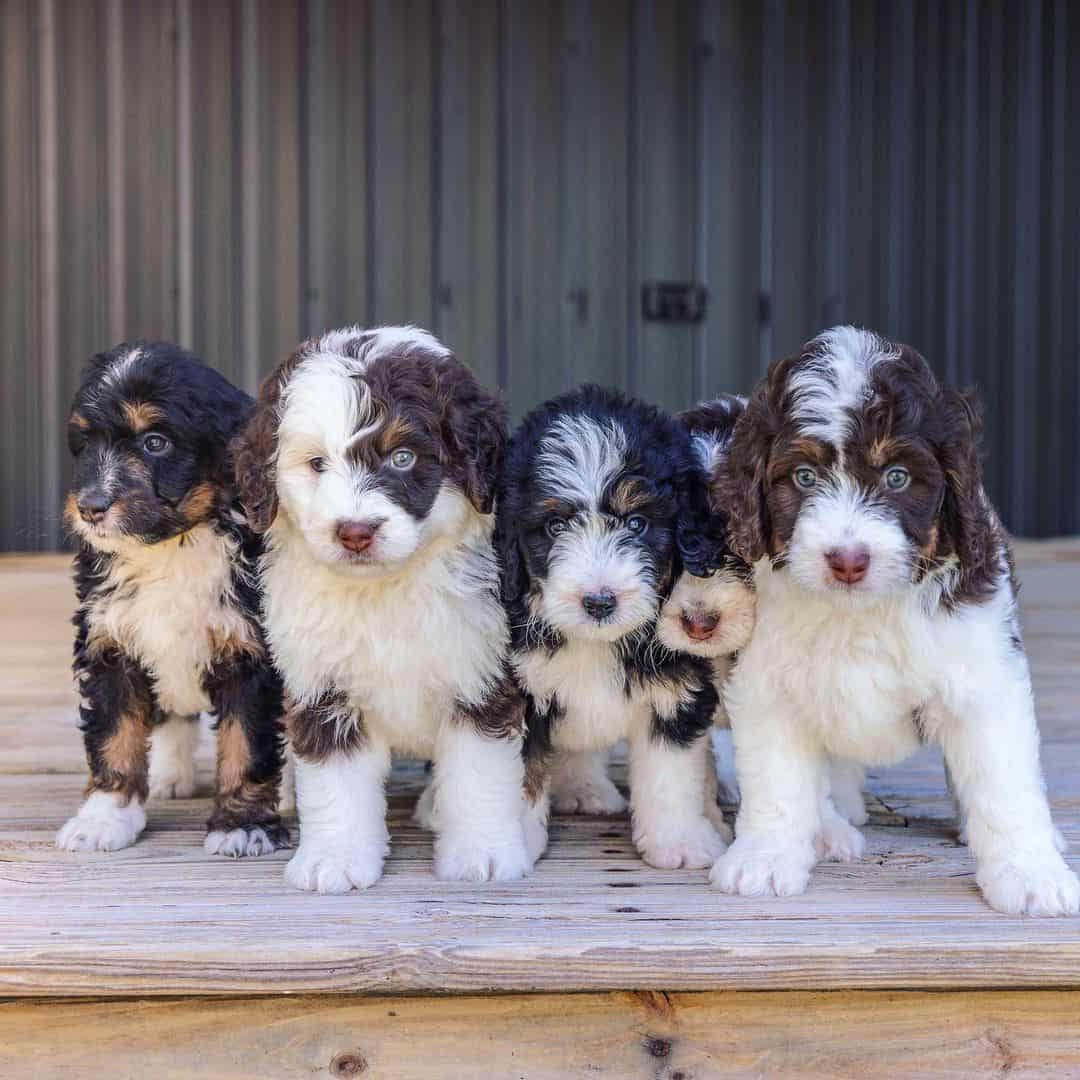
Photo from: @doodleselite
As you have probably guessed, Swiss Doodles are not cheap.
If you recall, the Crockett family was the one that first started breeding Swiss Doodles, and they are still some of the most reputable breeders around. According to their website, crockettdoodles.com, the prices for a Swiss Doodle puppy generally range from $900 to $2,800.
The price of a particular puppy will depend on several factors: age, color, bloodline, health, etc.
However, since they are so rare and difficult to produce, there simply isn’t enough of them around, so even if the price is not an issue for you, you might have to wait a while before you get your first Swiss Doodle.
Conclusion
We use the word “unique” to describe a lot of dog breeds, but Swiss Doodles are definitely one of the cases where it truly applies.
This crossbreed of two different tri-color mixed breeds is a one-of-a-kind combination with a fascinating genetic makeup. Even though they’ve only been around for less than a dog’s lifetime, their benevolent personality, good manners, and intelligence could quickly make them the favorite among dog owners.
This article was written for all of you who are hoping to adopt one soon, as well as those of you who simply wanted to know more about this incredible dog breed.
A lot of people probably didn’t even know that Swiss Doodles existed until now! But, they definitely do, and now you know everything there is to know about them.
